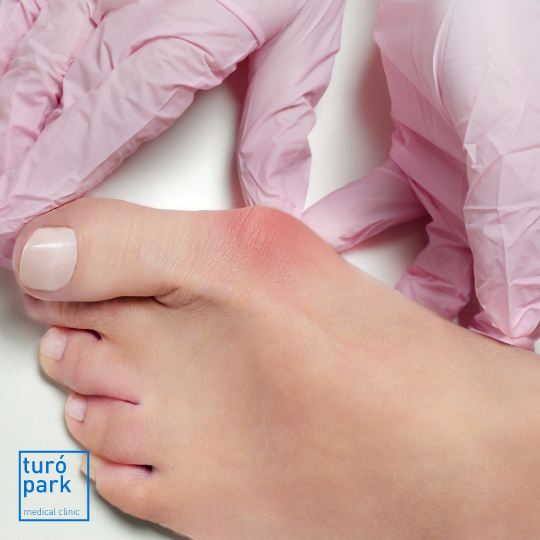Are you suffering pain, discomfort or embarrassment from a bunion on your feet, known as the hallux valgus, and want treatment in Barcelona?
A bunion, otherwise known as hallux valgus, is a foot deformity classed as an aesthetic problem, but above all, it can be very painful. It is often hereditary, and must be treated as soon as possible to avoid complications. Several approaches are possible depending on the development of the pathology so our podiatrists will be happy to advise you on the best treatment for you.
What is a bunion or hallux valgus?
Principally known as a "bunion", hallux valgus is a foot deformity where the big toe (hallux) gradually deviates towards the second toe, towards the inside of the foot. As a result, the joint between the metatarsal and the first phalanx of the big toe becomes very prominent, forming a bump on the inner edge of the forefoot.
Hallux valgus develops in phases:
- Mild hallux valgus: the deviation is less than 20°. The phalanx of the big toe and the metatarsal are still correctly interlocked.
- Moderate hallux valgus: the deviation is between 20° and 40°. The big toe turns towards the outside of the foot, the phalanx is displaced in relation to the metatarsal and no longer fits correctly. The big toe conflicts with the second toe.
- Severe hallux valgus: the angle of deviation is greater than 40°. The big toe passes under or over the second toe. Osteoarthritis accentuates the deviation, until it causes complete dislocation of the big toe joint, which thus loses its functionality.
What are the symptoms of bunions and hallux valgus?
The main symptom of hallux valgus is the progressive deformity of the big toe and then of the whole foot.
This condition is sometimes completely painless, but it is often painful to walk on, particularly due to friction in the shoe.
Calluses also often appear on the sole of the foot and corns on the lateral toes. The latter, driven by the big toe, curl up into "claws".
Other symptoms are: bursitis (painful and swollen redness on the bump) and nerve irritation of the medial dorsal nerve giving sensory disturbances at the tip of the big toe.

What causes a bunion to develop on the foot?
This condition affects the vast majority of women (nearly 9 out of 10 cases), especially between the ages of 40 and 60.
Several factors seem to favour and aggravate hallux valgus:
- Heredity (in 25% of cases, hallux valgus is hereditary)
- Wearing shoes with a high, tight heel, such as pumps, or shoes that are too tight,
- Egyptian foot (where the 2nd toe is longer than the first),
- Menopause (a relaxation of the fibrous structures favours the widening of the forefoot),
- Neuromuscular or rheumatic diseases or a collagen anomaly.
- Being overweight is also a contributing factor.
Hallux valgus: treatment and recommendations
It is possible to treat this pathology with three approaches depending on the stage of advancement of the hallux valgus:
- Orthesis: There are dressings to limit friction during the day, as well as splints or separators to be worn at night to keep the toe in the right alignment.
- Medical: Painkillers and anti-inflammatories can be used in acute forms of bursitis.
- Surgical: Corrective surgery for hallux valgus is the only curative treatment. It will correct the deviation, relieve the pain and of course avoid the evolution of the foot towards a complex forefoot. This operation is performed under general anaesthesia and must be followed by rehabilitation with a physiotherapist.
It is important to treat hallux valgus as early as possible to avoid complications, in particular the appearance of arthrosis in the foot or claw toes. When the bunion is mild, surgery can sometimes be avoided by wearing night orthotics or orthoplastics which will allow the correction of the deformity.
Bunion: FAQ
Our podiatrists

Andrea Cao
